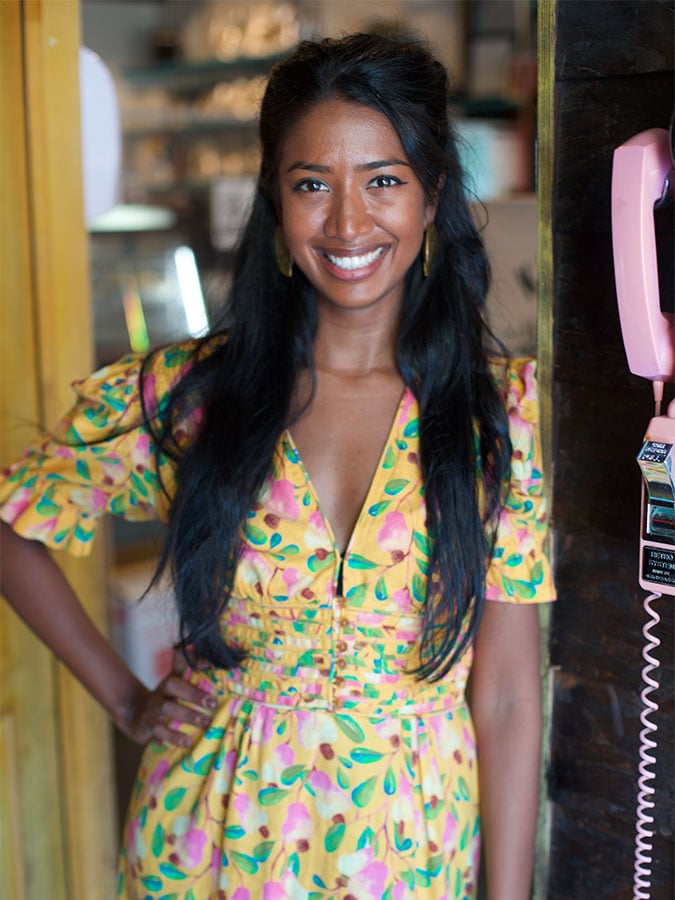Earthy mustard seeds popping like fireworks. The pungent fragrance of garlic and ginger, and the sizzle when they hit the pan. The scent of curry leaves blooming in oil. The sweetness of the steam rising from the rice cooker. As early as I can remember, the scents and flavors of food preparation have been the foundations of my formative memories. My mother cooked constantly, and since my dad had installed a huge industrial fan in the house, at a certain point of the day, a wave of fragrant fried onions and spices would hit my brother and me as we played outside, our noses—not our timepieces—inviting us home for dinner. I could always tell what we were having and how she had cooked it from the scent, not because I had any sort of special skills, but because I loved it all so much. Growing up in a South Indian family in rural western Pennsylvania was turbulent for many reasons, but anticipating, assessing and rhapsodically devouring food at home was my constant anchor and relief.


Photo by Chancelor Humphrey
I recall these memories because I felt a similar rush of emotion the first time I was ever truly moved by a wine. I had only very recently started my restaurant career, and was asked to serve Arianna Occhipinti’s SP68 Bianco. I had memorized all of the technical information and was ready to dutifully repeat it if asked. When I actually smelled and tasted the wine, however, I felt the same brain-brightening joy that I’d get from a whiff of my mom’s food. I remember immediately thinking of what I’d like to eat with it (a spiced Kerala chicken roast), and who I’d like to share it with. I remember being amazed and delighted that a wine could capture so much nuance of scent and flavor and translate it to me the same way food did, but through a single ingredient. At the time, I didn’t share any of that with my guests. I didn’t feel like it would add anything to their experience.
A few years later, a very generous cousin invited me to dinner at Le Bernardin. Though I did not plan to introduce myself to Aldo Sohm, the beverage director, he learned from my cousin that I was working as a sommelier in Pittsburgh. Aldo offered to blind-taste me on the wines that accompanied my dinner, listening as I babbled about how I felt about them—putting, as my mother would say, my own masala on the story. Then, he offered me a job. I believed him to be simply humoring a slightly tipsy, wide-eyed baby somm, but he was serious. I moved to New York just a few weeks later.
Adjusting to the pace of the city was one of the most challenging things I’ve ever done. I was suddenly serving bottles I had only ever read about, under the scrutiny of one of the most well-regarded dining teams in the world. It was exhilarating and exhausting in equal measure. My knowledge grew exponentially as I gained experience; when it came to studying, I was very good at learning what to say and how to say it. As an Indian-American woman who had lived, worked and studied in predominantly white spaces, assimilation had been part of how I measured success. And though I was proud of my ability to adapt in New York, one thing didn’t change: the nightly expressions of polite surprise to see a non-white woman in this role. My white colleagues never seemed to get the same inquiries. I felt like I had to work much harder to prove my capability on the floor while maintaining composure and grace—that I had to perform a certain way, maintain a distance and a rigid formality that fit the guest’s idea of what a sommelier was supposed to be.
When I smelled and tasted the wine, I experienced the same brain-brightening joy that I’d get from a whiff of my mom’s food.
It’s easy to see in hindsight what I didn’t understand then: None of that was why Aldo had hired me. He has told me since that he recognized a spark, a passion, and a joy in me when I spoke about wine, that it was palpable and that I could pass it effectively to those around me. I didn’t see this as an asset—in fact, I didn’t really see any of my background, experience or ability as anything other than a hindrance to the “correct” way of being in fine dining, until I started to work on my business, Kalamata’s Kitchen—food adventures for kids. As I started to craft the character of Kalamata, I made her into the little girl I wish I had been from the beginning, wanting her to be a role model, hero and friend to kids today. Writing children’s books about Kalamata, I also started, not entirely consciously, to really be that person myself. Maybe it was the total lack of sleep from working on the floor and building the business during my off hours, but suddenly I had no energy and no desire to be anyone other than, authentically, me in either role. My experiences were a gift, not a barrier. My work as a sommelier was likely never better than that period when I was doing both jobs.
I had given up diluting the way I expressed my own experiences. Instead, I was using that masala (thanks, Mom) as an opportunity to connect with people—who might be feeling lost in a space themselves—by sharing conversations about wine and food.
This story appears in the print issue of Spring 2022.
Like what you read? Subscribe today.















